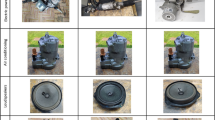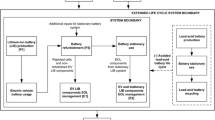Abstract
Increasing attention is currently given to the management of end-of-life (EoL) hybrid electric vehicles (HEVs), because approximately two decades have passed since they were first introduced to the market. A HEV would be one of the largest consumers of rare earth elements (REEs), and hence represents the greatest potential for REE recovery in the future. The purpose of this study is to clarify the present and future recovery potential of REEs that are disposed of as EoL HEVs. This study first estimated the numbers of EoL HEVs during fiscal years (FYs) 2010–2030, and then clarified the potential for recovery of REEs from two HEV-specific components—the hybrid transmission and NiMH battery unit. The results suggest that 0.51–0.65 million HEVs will reach the EoL stage in FY2030, compared with only 11,000 HEVs in FY2010. As of FY2030, REE recovery potentials will increase to 220 tons and 2900 tons for EoL hybrid transmission and NiMH battery units, respectively. A total of 49,000 tons of REEs will be contained within HEV-specific components of HEVs still in use. Moreover, the potential for recovery of REEs from EoL hybrid transmissions and NiMH battery units is estimated to equal 35.4 and 92.1 % of respective demand.









Similar content being viewed by others
References
Japan Automobile Manufacturers Association, Inc. (2012) World motor vehicle statistics
ChinaAutoWeb website. http://chinaautoweb.com/2014/02/chinas-auto-fleet-expands-to-137-million/. Accessed 4 Jul 2014
Next-generation vehicle promotion center (NeV) website, http://www.cev-pc.or.jp/tokei/hanbai.html. Accessed 11 Jul 2014. (in Japanese)
Sakai S, Yoshida H, Hiratsuka J, Vandecasteele C, Kohlmeyer R, Rotter VS, Passarini F, Santini A, Peeler M, Li J, Oh G, Chi NK, Bastian L, Moore S, Kajiwara N, Takigami H, Itai T, Takahashi S, Tanabe S, Tomoda K, Hirakawa T, Hirai Y, Asari M, Yano J (2014) An international comparative study of end-of-life vehicle (ELV) recycling systems. J Mater Cycles Waste Manag 16(1):1–20
Ministry of Economy, Trade and Industry (METI) (2012) Current situation about the recycling of critical metals in Japan (in Japanese). http://www.meti.go.jp/policy/recycle/main/admin_info/committee/a/22/hairi22_03.pdf. Accessed 31 Jul 2014
Hoenderdaal S, Espinoza LT, Marscheider-Weidenmann F, Graus W (2013) Can a dysprosium shortage threaten green energy technologies? Energy 49:344–355
Seo Y, Morimoto S (2014) Comparison of dysprosium security strategies in Japan for 2010–2030. Resour Policy 39:15–20
METI (2009) Strategy for ensuring stable supplies of rare metals (in Japanese)
Du X, Graedel TE (2011) Global in-use stock of the rare earth elements: a first estimate. Environ Sci Technol 45(9):4096–4101
Sprecher B, Kleijn R, Kramer GJ (2014) Recycling potential of Neodymium: the case of computer hard disk drives. Environ Sci Technol 48(16):9506–9513
Alonso E, Wallington T, Sherman A, Everson M (2012) An assessment of the rare earth element content of conventional and electric vehicles. SAE Int J Mater Manf 5(2):473–477
Automobile Inspection and Registration Information Association (AIRIA) (1998–2013) Vehicles in use of Japan based on the first registered year, pp 26–41(in Japanese)
Japan Automobile Dealers Association (JADA) (2009) Future sales for new vehicle prospect (in Japanese)
METI (2010) Next-generation vehicle strategy 2010 (in Japanese)
Daigo I, Hashimoto S, Matsuno Y, Adachi Y (2009) Material stocks and flows accounting for copper and copper-based alloys in Japan. Resour Conserv Recycl 53(4):208–217
Polák M, Drápalová L (2012) Estimation of end of life mobile phones generation: the case study of the Czech Republic. Waste Manag 32(8):1583–1591
Yano J, Hirai Y, Okamoto K, Sakai S (2014) Dynamic flow analysis of current and future end-of-life vehicles generation and lead content in automobile shredder residue. J Mater Cycles Waste Manag 16(1):52–61
Sakai S, Yano J, Muroi T, Watanabe N (2013) Dismantling of conventional and hybrid vehicles for end-of-life vehicle management. In: Proceedings of ISWA 2013 World Congress, Vienna, Austria
Acknowledgments
This research was supported by the Environment Research and Technology Development Fund, Grant Number K123001, from the Ministry of the Environment, Japan.
Author information
Authors and Affiliations
Corresponding author
Electronic supplementary material
Below is the link to the electronic supplementary material.
Rights and permissions
About this article
Cite this article
Yano, J., Muroi, T. & Sakai, Si. Rare earth element recovery potentials from end-of-life hybrid electric vehicle components in 2010–2030. J Mater Cycles Waste Manag 18, 655–664 (2016). https://doi.org/10.1007/s10163-015-0360-4
Received:
Accepted:
Published:
Issue Date:
DOI: https://doi.org/10.1007/s10163-015-0360-4




